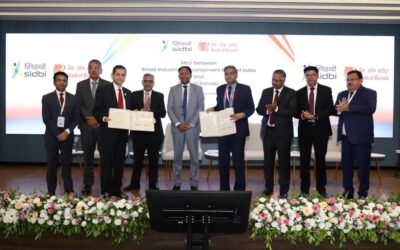Navigating Compliance Complexity: How India’s MSMEs Can Thrive Amid 1,450+ Regulations

As India races toward its ambitious goal of becoming a $1 trillion manufacturing economy by 2030, its micro, small and medium enterprises (MSMEs) remain the heartbeat of industrial growth. With over 6.3 crore MSMEs contributing to employment, innovation, and exports, the sector’s success is vital for sustaining India’s economic momentum. Yet, as of October 2025, these very enterprises face one of their toughest challenges a dense web of regulations and compliances that often impede progress rather than enabling it.
Regulation is meant to safeguard fairness, quality, and safety, but for MSMEs, the growing complexity, duplication, and frequency of policy changes have turned it into a persistent obstacle. For entrepreneurs, this burden doesn’t just translate into administrative hassle; it directly influences competitiveness, profitability and survival.
The Compliance Overhang: A 2025 Reality Check
The compliance ecosystem for Indian MSMEs has become more complex over time. According to the latest TeamLease RegTech data, a typical manufacturing enterprise must now adhere to over 1,450 statutory obligations annually, spread across seven major domains taxation, labour, safety, environment, corporate, commercial and general administration. Each factory is required to maintain 48 different registers and is subject to 59 distinct types of inspections every year, covering everything from pollution and safety to tax and industrial licensing.
What exacerbates the problem is the constant change. India’s regulatory framework witnesses an average of more than 45 updates per day, each requiring monitoring and interpretation. For small units without dedicated compliance departments, staying current is nearly impossible. To complicate matters further, state-level laws often vary sharply, creating confusion and duplication for businesses operating in multiple locations. For instance, a textile MSME in Gujarat may follow entirely different documentation requirements from a similar unit in Tamil Nadu or Karnataka.
Financial Stress: Calculating the True Cost of Compliance
For most MSMEs, compliance is no longer just a bureaucratic exercise it’s an expensive operational cost. On average, small and mid-sized manufacturers spend between ₹16 and ₹22 lakh annually on direct compliance costs, which include consulting fees, audits, software subscriptions and filings. But the real burden is far greater when one accounts for indirect costs: the lost managerial time, delayed decision-making and missed investment opportunities caused by uncertainty or fear of non-compliance.
The consequences of even minor errors can be severe. Many regulations still include punitive measures, where administrative lapses lead to disproportionate penalties or even criminal liability. For businesses operating on tight margins, these risks discourage innovation and expansion. Rather than channelling resources into R&D, digitization or export diversification, MSMEs are forced to allocate funds and manpower to maintain compliance.
Criminalization and Fear: The Hidden Tax on Enterprise
One of the most pressing concerns for entrepreneurs is the criminalization embedded in India’s regulatory system. Among more than 26,000 imprisonment clauses across various statutes, only a fraction has been rationalized or removed in recent years. This means that even procedural mistakes such as a delayed report or a missing signature can invite criminal prosecution.
The fear of enforcement visits, penalties, or litigation discourages risk-taking. Many MSME owners adopt an overly cautious, compliance-heavy stance to avoid scrutiny, often at the expense of growth. This culture of regulatory fear has, over time, created a psychological “hidden tax” an unseen cost of doing business that erodes productivity and ambition.
Sectoral Impact: When Regulations Outpace Reality
The regulatory pressure is not evenly distributed. Certain industries face more acute challenges than others. In pharmaceuticals, for example, the implementation of Revised Schedule-M norms now mandates bio-equivalence studies for drug formulations, costing anywhere between ₹25 lakh and ₹50 lakh per product. For small drug manufacturers, these costs are simply unaffordable and risk forcing thousands of units to close.
Similarly, steel MSMEs must now comply with stringent Bureau of Indian Standards (BIS) certification rules for imported raw materials, leading to higher procurement costs, longer lead times and compliance bottlenecks. In the chemicals sector, new ESG-related obligations on waste management, water audits and emissions monitoring have layered on top of existing safety and environmental laws, often without standard templates or digital mechanisms for compliance. The cumulative result is the same across industries compliance overload that outpaces the capacity of smaller enterprises to respond.
Policy Efforts and Reforms: Progress, but Partial
The Indian government has acknowledged these pain points and rolled out several measures in recent years to simplify the compliance ecosystem. Initiatives such as the PAN 2.0 Universal ID, currently piloted in four states, aim to unify multiple registrations across ministries under a single identification framework. Likewise, the launch of EntityLocker, a digital repository for storing and accessing all approvals and certificates, marks a step toward transparency and paperless governance.
Further, the introduction of faceless inspections in 35 districts has reduced physical visits by nearly 40%, improving efficiency and curbing corruption. The MSME Amendment Bill (2025) has also made strides by decriminalizing certain minor offences, converting them into civil penalties. However, these reforms remain fragmented and inconsistent in implementation. While central agencies have shown some agility, many state-level departments continue to follow outdated, manual processes.
The ESG and Digital Divide: The Next Challenge
Beyond traditional compliances, the expanding scope of Environmental, Social, and Governance (ESG) mandates is presenting new complexities for MSMEs. Requirements around carbon reporting, waste segregation and diversity disclosures are becoming standard, even for smaller firms that lack the technical resources or systems to comply. For many MSMEs, especially those without enterprise-level data capabilities, these expectations are difficult to meet.
Compounding this challenge is the digital divide. Only around 30% of manufacturing MSMEs in India currently use digital compliance platforms or enterprise software for reporting and tracking. The remaining 70% rely on manual processes, spreadsheets, or local consultants. This not only increases human error but also limits real-time oversight, leaving firms vulnerable to missed updates or regulatory lapses. Without targeted digital training and incentives, many small manufacturers risk being left behind in an increasingly compliance-driven economy.
The Economic Toll and Industry Sentiment
Surveys by CII, FICCI, and KPMG during the third quarter of 2025 underline the gravity of the situation. More than half of MSMEs (56%) have deferred their growth or investment plans because of regulatory uncertainty or fear of penalties. Another 40% reported facing enforcement actions in the past year for missing updates or filing deadlines. A striking 85% of respondents expressed the need for a centralized compliance dashboard that integrates state and central obligations, tracks deadlines and issues real-time alerts.
This data reflects a sector trapped in compliance paralysis one where excessive paperwork and procedural fatigue dampen competitiveness and innovation. It also raises a policy question: can India truly achieve manufacturing-led growth when its most dynamic enterprises are shackled by compliance anxiety?
From Burden to Opportunity: A Strategic Roadmap
The path forward lies in transitioning from a compliance-heavy to a compliance-smart framework. India’s policymakers and industry associations need to focus on three broad priorities.
First, there must be regulatory harmonization and simplification. A single-window compliance passport that unifies filings across ministries and states could dramatically cut duplication and confusion. Central and state laws should be standardized, with outdated provisions retired.
Second, digital transformation must become a national priority for MSMEs. The government can subsidize cloud-based compliance tools, encourage the use of RegTech platforms, and expand digital repositories like EntityLocker nationwide. Automation and AI-driven monitoring systems can make compliance proactive rather than reactive.
Third, risk-based and faceless inspection systems should be institutionalized. Virtual audits can replace most physical inspections for low-risk enterprises, saving time and reducing discretion. A specialized Compliance Appeal Tribunal for MSMEs could also offer quick, low-cost dispute resolution, replacing the current system of protracted litigation.
These initiatives, coupled with capacity-building workshops, simplified monthly digests of rule changes, and a continuous dialogue between regulators and industry, can shift compliance from an adversarial process to a collaborative one.
The Road to 2030: A Moment of Reckoning
India’s manufacturing MSMEs stand at an inflection point. Global supply chains are reorganizing, and the world is looking for stable, efficient manufacturing destinations. With genuine reform and digital adoption, India can unlock ₹1.5 to ₹2 lakh crore in annual productivity gains. But this requires commitment, execution, and a shift in mindset from regulatory policing to regulatory partnership.
From Survival to Strategic Growth
The MSME sector’s resilience has long been India’s economic backbone, but resilience alone is not enough. Excessive and overlapping compliance obligations are draining resources, curbing innovation and distorting market competitiveness. Simplifying, digitizing, and humanizing compliance must become a top national priority.
A smart, harmonized, and technology-driven regulatory framework can turn compliance from a burden into a competitive advantage empowering India’s MSMEs to focus on what they do best: creating value, generating jobs, and driving industrial transformation. In 2025, as India aims for global manufacturing prominence, the time to act on regulatory reform is not tomorrow it is today.











